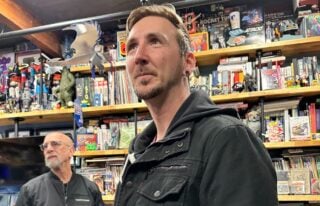Who is Mark Cerny, the man behind PS5?
An in-depth profile of Sony’s influential, yet independent architect

After almost 40 years of making games, there are few individuals with a more impressive career than Mark Cerny.
The multi-skilled creator has enjoyed a long and storied career in the games industry, which began in the booming arcade era of the early 80s and today sees him still at the cutting-edge of video games hardware, as the architect of PlayStation 5.
He’s been a programmer, producer, designer and businessman for companies including Atari, Sega and Crystal Dynamics. But it’s Sony’s gaming arm he’s most closely associated with, having worked with the PlayStation creator in various roles for over two decades. However, Cerny has – amazingly – never been a direct employee at PlayStation.
Cerny’s fingerprints are on countless iconic PlayStation franchises he helped create, but he’s also fundamentally shaped how we play games on Sony’s consoles, having been the lead system architect of both PlayStation 4 and PlayStation Vita.
And having played a key role in Sony achieving market dominance during the current console generation, Cerny has been entrusted to help replicate that success as the chief architect of PlayStation 5.
Further reading:
Atari, Sega and Beyond
Mark Cerny was raised in the San Francisco Bay Area and attended the University of California, Berkeley. However, at just 17 the opportunity to work for Atari was too good to refuse, and saw the young programmer drop out of education and join the gaming giant’s flagship arcade division. It wasn’t long before he was making a name for himself as designer and co-programmer for classic arcade game Marble Madness (1984).

Cerny’s keen interest in hardware was evident at an early age, when he singlehandedly designed and built an arcade board system.
“Hardware development in 1985 was very different to today,” Cerny explained in the August 2013 edition of Develop magazine.
“I did a fairly advanced arcade hardware design as one guy. Back then you could just go out and buy chips and put them on a board. But today we are talking about huge transistor counts, and the chips are compiled. You aren’t in there positioning each transistor yourself.”
By the late 1980s Cerny was ready for his next move. The young programmer and designer joined Sega, thus starting a long association with Japan. He spent over three years working in Tokyo on Master System titles including Shooting Gallery (1987) and Missile Defense 3-D (1987), the latter of which was compatible with what Cerny called the “moderately successful” active shutter 3D glasses he helped create.
It was during his time in Japan that Cerny learnt to speak the Japanese language fluently and met his future wife, who would go on to look after all business affairs at their consultancy, Cerny Games.

In 1991 Cerny’s desire to create his own team, combined with Sega’s intention to expand its presence in the US, saw him return to the States to found the Sega Technical Institute. The development division would go on to be responsible for Genesis/Mega Drive titles Sonic the Hedgehog 2 (1992) and Kid Chameleon (1992).
But it wouldn’t be long before another Japanese company came knocking, marking the defining relationship of his career.
Where is Mark Cerny from?
Burbank, California, United States
What did Mark Cerny invent and design?
PlayStation 4, PlayStation Vita and PlayStation 5 hardware. Cerny has also worked on countless video games including Sonic the Hedgehog, Crash Bandicoot, Ratchet and Clank, Spyro the Dragon and Knack.
The Sony connection
In 1992 Cerny left Sega to join a new games studio, Crystal Dynamics, where he became the very first member of its games team, working on 3DO titles Crash ‘n Burn (1993) and Total Eclipse (1994).
In 1994 Crystal Dynamics became the first US company to procure a PlayStation development kit, after Cerny visited its Tokyo headquarters and brokered a deal, approved by a young executive named Shuhei Yoshida.
Cerny confessed years later that he never actually got to use that devkit, because in 1994 he got “a very big break” when he was recruited to lead entertainment conglomerate Universal Studios’ entrance into the multimedia space with the launch of Universal Interactive Studios.
He served as VP of product development and later president of the division during a four-year spell. “The best part about this was that Universal didn’t really know the business and as a result I had a great big bag of money to spend and no supervision,” he told 2013’s Develop Conference in Brighton.
“We ended up signing a three-person company called Naughty Dog and the result was Crash Bandicoot. We signed a two-person start-up called Insomniac Games with no prior experience making games and the result was Spyro the Dragon.” Cerny served as executive producer on those titles, which went on to sell over 20 million units combined.
When Universal’s contracts with Naughty Dog and Insomniac ended, the studios began creating games directly for Sony, which had previously licensed the distribution rights from Universal. The PlayStation firm would go on to acquire the future Uncharted and The Last of Us studio in 2001, and to purchase the future Spider-Man developer for $229 million in 2019.
Keen to continue his working relationship with the studios, Cerny decided to go independent and form his own consultancy, Cerny Games. “I really had a choice I had to make, which was either to stay with Universal and try to make everything work as an executive there, or to go independent and work as a consultant to Naughty Dog, Insomniac, and Sony–to be working for teams that I loved,” he told Fast Company. “And of course I chose the latter.”

By early 1999, working prototypes of PlayStation 2 had been completed and a top-secret team of programmers in Tokyo were quietly working on demos ahead of the system’s official reveal.
Wanting to ensure Naughty Dog and Insomniac got off to a fast start on the new console, Yoshida, then PlayStation’s executive producer of product development, extended his old acquaintance an invitation to join the Tokyo team to work on a graphics engine for PS2. Cerny accepted and became the first American to get his hands on the system during another three-month spell living in Japan.
He went on to work on Naughty Dog’s and Insomniac’s debut PS2 titles, as programmer for Jak & Daxter: The Precursor Legacy (2001) and designer for Ratchet & Clank (2002) respectively, in addition to multiple sequels.
The Cerny Method
Cerny used his experience working with Naughty Dog and Insomniac to create a unique production methodology, which he calls ‘Method’. ‘Method’ is hugely influential across game studios today, and emphasises creative freedom and risk taking in the pre-production phase, allowing developers to settle on a design before fleshing it out in full production.
Cerny explained in 2002 that pre-production, when developers attempt to ‘capture lightning’, and production, when they build the game, are two phases as “different as night and day”. By the end of pre-production, you’ve created what he calls a “publishable first playable,” a completely polished portion of the game that determines whether the project will live or die.
“Pre-production must be allowed to be a chaotic process,” he said. “You can’t plan when inspiration will strike and you can’t schedule the date when you’ll have worked out all your seemingly intractable problems.
It’s not just a bad idea to schedule, he said, it’s impossible: “And those who do plan and schedule pre-production end up in one of two boats. Those who are so frustrated or disillusioned that they cancel the project, or those who build a project that is not yet ready and therefore carries all of its deficiencies over into production.”
80% of mistakes in game development are direct results of things that were done or not done in pre-production, Cerny claimed.
“[Cerny’s method] has been picked up pretty much by everyone in the business. It’s been a huge influence, and not many people outside the industry really appreciate that.”
Ben Cousins, an independent consultant and industry veteran, said of Cerny’s Method during a 2013 Wired interview: “It has been picked up pretty much by everyone in the business. It’s been a huge influence, and not many people outside the industry really appreciate that.”
Cerny has contributed to or led various technology initiatives at Sony. In 2003 Yoshida, now vice president of product development at Sony Computer Entertainment America (SCEA), was concerned about the rising cost of game development and what could be a complex generational transition to PS3.
He believed technology sharing could be one solution, and Cerny was appointed to form a specialised technology group whose function was to spearhead SCE’s entry into the next generation. The result was the ICE (Initiative for a Common Engine) Team, a central technology group based out of Naughty Dog to this very day, which focuses on creating core graphics technologies used by all PlayStation developers.

While the PS1 and PS2 hardware teams had worked in complete isolation without input from game creators, Yoshida’s plan was to embed ICE Team programmers with the PS3 hardware team in Tokyo as the console was being built.
While extremely powerful, unlocking the capabilities of PS3’s Cell processor proved to be notoriously difficult. “As a programmer it’s kind of like a Rubik’s Cube,” Cerny said. “Both the unique nature of Cell and the primitive state of the development environment meant that game creation on PS3 was more time consuming than on any previous platform.”
First party teams had a difficult time making PS3 games in the early days and third parties struggled even more, resulting in a “weak” line-up of launch titles in late 2006.
Cerny worked as a design consultant on first-party PS3 games including Resistance: Fall of Man (2006), Uncharted: Drake’s Fortune (2007), Ratchet & Clank Future: Tools of Destruction (2007), God of War III (2010) and Killzone 3 (2011), but for most of this period he was engaged in a bigger project.
The architect
When Sony conducted a PS3 postmortem in 2007, there were two main options for its next console’s CPU: the power PC architecture used in PS3’s Cell, or the x86 CPU used in pretty much every modern PC, which Cerny said first-party developers advised against using.
So the engineer ended up spending his holiday in November 2007 researching the 30-something year history of the x86, from its creation in the 1970s all the way through the most recent enhancements. During his research Cerny discovered a passion and enthusiasm for system design he previously didn’t know he had.
He told the Develop Conference: “I started thinking, I just sacrificed my holiday to investigate some philosophical part for a console that I’m not really assigned to be working on, that won’t be released for at least five years. That’s passion, that’s enthusiasm, maybe I should consider working on this project more deeply.”
By 2007, Cerny had been a designer and programmer at Atari, become fluent in Japanese through his years at Sega, programmed graphics engines at Crystal Dynamics and Naughty Dog, and worked as an executive producer at Universal Studios. He decided that if anyone was qualified enough to design the next PlayStation console, it was him.
“I knew it was a bit audacious, but I then went to see Yoshida and I pitched him on the idea that I would be the lead architect for the PS4,” he said. “To my amazement, Shu said yes, it’s a good idea. So I went to the head of the Worldwide Studio who also agreed, then I went to Masa Chatani who was the CTO at the time and to my amazement, Masa said yes, but I would have to leave the Worldwide Studio and work through SCE headquarters instead, because that’s of course where the hardware project would be based.”
Despite being given the huge responsibility of designing the next PlayStation, Cerny was still not a Sony employee, and he believes this lack of formal status was of great benefit to both himself and the PS4’s early conception.
“As a consultant, I manage no employees, I’m not responsible for budgets, I don’t give presentations to other divisions of Sony, I don’t track progress versus milestones, I don’t negotiate contracts. I’m free to think about where we need to be in five years’ time and work with the appropriate groups inside and outside of the company in order to make that happen.
“Despite being given the huge responsibility of designing the next PlayStation, Cerny was still not a Sony employee, and he believes this lack of formal status was of great benefit to both himself and PS4.”
“In some ways it’s a bit like being a director on a game title, which is to say that certainly there are many programmers and artists and designers involved when you make a game but they report to managers, not to the director. And there’s certainly a budget that has to be tracked when you make a game, but it’s managed by the producer. The director’s role is to shape the shared vision and communicate it to the team.”
In early 2008 development of the PlayStation 4 began in earnest and Sony looked to apply the lessons it had learnt from the failings of the previous generation.
The new set of principles it followed meant the company was far more collaborative, both across its international divisions and in its openness with third party studios. External developers were this time viewed as vital to the console’s success from the outset and consulted early on about the specifics of what they’d like to see in the next generation system.
The key mission of PS4 was to create a developer friendly console and Cerny pushed to kick off its software and tools effort simultaneously with the development of its hardware – a lesson he learnt from his early days working in the arcade business.

The strategy paid off, big time. Backed by a more consistent stream of quality first and third party software over the years, PS4 has shipped 108.9 million units as of December 31, 2019, with more than 106 million units sold through to consumers, making it the second best-selling console of all time behind only PS2.
Ahead of arguably his greatest achievement, Cerny was celebrated by his peers as the 13th inductee into the Academy of Interactive Arts & Sciences Hall of Fame. “Mark Cerny is the closest we have come to a modern-day Da Vinci,” AIAS president Joseph Olin said.
“He is a diversely accomplished game designer, producer, programmer and technologist. Fluent in Japanese and one of the foremost Western experts on the Japanese game market, he’s also one of the only top-level independents in a business dominated by institutions. His contributions to projects have been phenomenally successful, with sales of almost two billion dollars and over a dozen titles each exceeding two million units in sales.”
In the years that followed, Cerny had a hand in the creation of some of PS4’s most recognisable software, directing launch title Knack (2013) and sequel Knack 2 (2017), serving as executive producer on The Last Guardian (2016) and Marvel’s Spider-Man (2018), and most recently as technical producer on Death Stranding (2019).
With such a storied career behind him, it’s amazing to think Mark Cerny’s incredible CV will swell even further with the upcoming launch of PlayStation 5, a system he is again responsible for creating.
Like its predecessor, PS5 accommodates features heavily requested by the development community, including a solid-state drive capable of dramatically reducing loading times and greatly speeding up how quickly environments can be rendered in-game.
The feature is billed by Cerny as “a true game changer.” And if there’s anybody who can pinpoint the key to the next generation, it’s him.















